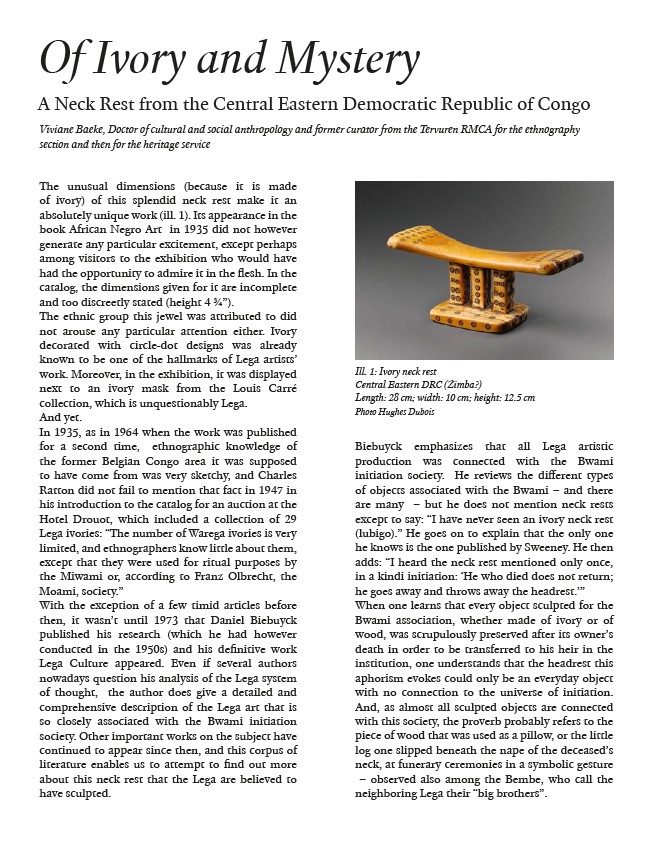
Of Ivory and Mystery
A Neck Rest from the Central Eastern Democratic Republic of Congo
Viviane Baeke, Doctor of cultural and social anthropology and former curator from the Tervuren RMCA for the ethnography
section and then for the heritage service
The unusual dimensions (because it is made
of ivory) of this splendid neck rest make it an
absolutely unique work (ill. 1). Its appearance in the
book African Negro Art in 1935 did not however
generate any particular excitement, except perhaps
among visitors to the exhibition who would have
had the opportunity to admire it in the flesh. In the
catalog, the dimensions given for it are incomplete
and too discreetly stated (height 4 ¾”).
The ethnic group this jewel was attributed to did
not arouse any particular attention either. Ivory
decorated with circle-dot designs was already
known to be one of the hallmarks of Lega artists’
work. Moreover, in the exhibition, it was displayed
next to an ivory mask from the Louis Carré
collection, which is unquestionably Lega.
And yet.
In 1935, as in 1964 when the work was published
for a second time, ethnographic knowledge of
the former Belgian Congo area it was supposed
to have come from was very sketchy, and Charles
Ratton did not fail to mention that fact in 1947 in
his introduction to the catalog for an auction at the
Hotel Drouot, which included a collection of 29
Lega ivories: “The number of Warega ivories is very
limited, and ethnographers know little about them,
except that they were used for ritual purposes by
the Miwami or, according to Franz Olbrecht, the
Moami, society.”
With the exception of a few timid articles before
then, it wasn’t until 1973 that Daniel Biebuyck
published his research (which he had however
conducted in the 1950s) and his definitive work
Lega Culture appeared. Even if several authors
nowadays question his analysis of the Lega system
of thought, the author does give a detailed and
comprehensive description of the Lega art that is
so closely associated with the Bwami initiation
society. Other important works on the subject have
continued to appear since then, and this corpus of
literature enables us to attempt to find out more
about this neck rest that the Lega are believed to
have sculpted.
Ill. 1: Ivory neck rest
Central Eastern DRC (Zimba?)
Length: 28 cm; width: 10 cm; height: 12.5 cm
Photo Hughes Dubois
Biebuyck emphasizes that all Lega artistic
production was connected with the Bwami
initiation society. He reviews the different types
of objects associated with the Bwami – and there
are many – but he does not mention neck rests
except to say: “I have never seen an ivory neck rest
(lubigo).” He goes on to explain that the only one
he knows is the one published by Sweeney. He then
adds: “I heard the neck rest mentioned only once,
in a kindi initiation: ‘He who died does not return;
he goes away and throws away the headrest.’”
When one learns that every object sculpted for the
Bwami association, whether made of ivory or of
wood, was scrupulously preserved after its owner’s
death in order to be transferred to his heir in the
institution, one understands that the headrest this
aphorism evokes could only be an everyday object
with no connection to the universe of initiation.
And, as almost all sculpted objects are connected
with this society, the proverb probably refers to the
piece of wood that was used as a pillow, or the little
log one slipped beneath the nape of the deceased’s
neck, at funerary ceremonies in a symbolic gesture
– observed also among the Bembe, who call the
neighboring Lega their “big brothers”.